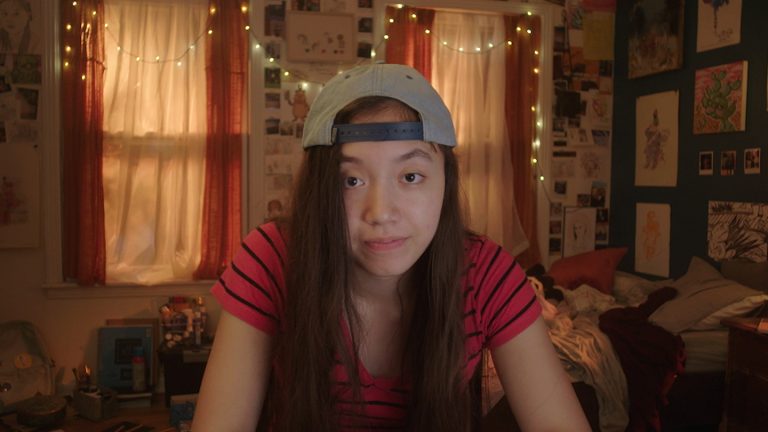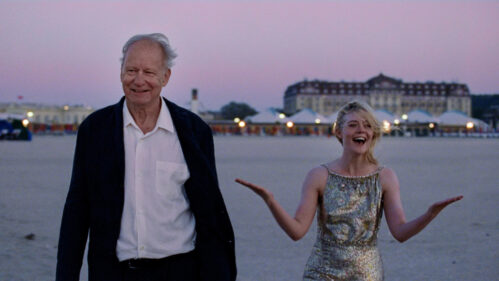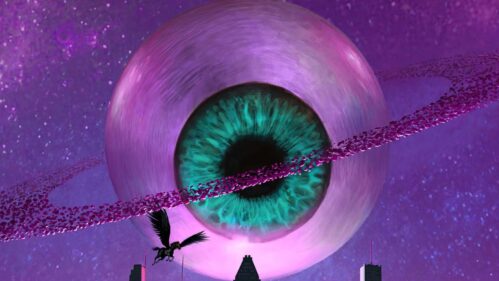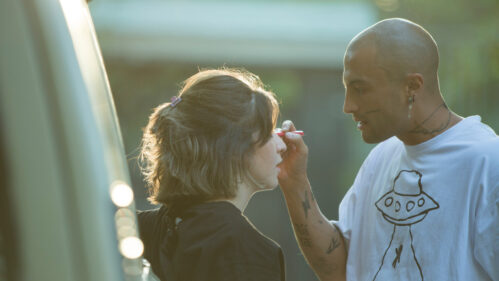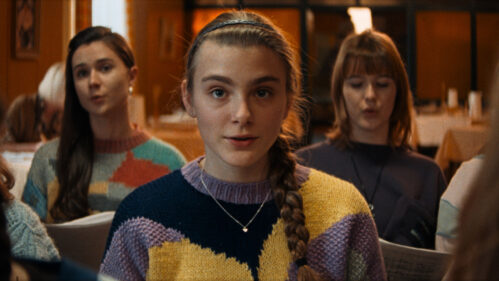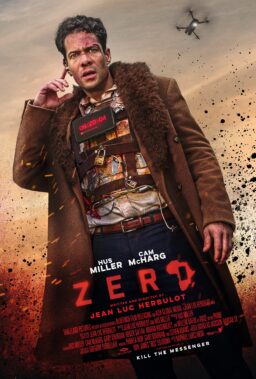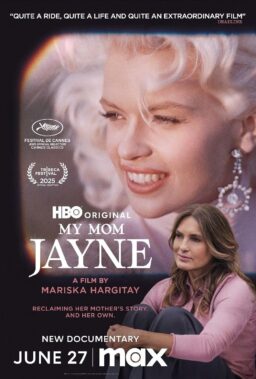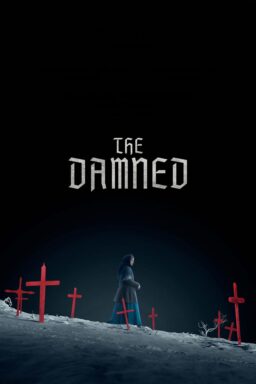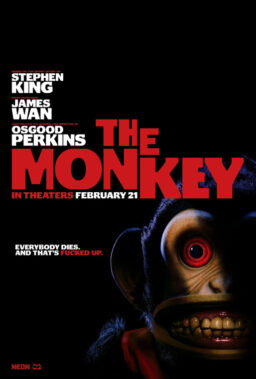“Inbetween Girl” enters the crowded field of coming-of-age stories with a standout directorial approach, with writer/director Mei Makino proving to be a storyteller who treats a lot of scenes with immense care. The constructs are recognizable here in a way that high school is itself a cliche, but the way that Makino tells this story is noteworthy, heartfelt, and funny.
Makino’s story is all about Angie Chen (Emma Galbraith in a confident beyond her years, sardonic performance), a teenager at a private religious school who does not really fit in, have deep friendships, or have a sense that she’ll miss these years. Like Bo Burnham’s “Eighth Grade,” Angie is making a time capsule for her future self, documenting the schoolmates and experiences she currently has, but with a flippant narration. And because she’s an artist, the time capsule footage includes Angie filming her drawings, a clever and practical way to bring some visual imagination to her character.
Angie’s tension with the world around her is further exacerbated when her parents get a divorce, and her father soon starts dating someone else. She finds some solace in hanging out with her friend Liam, but he quickly pushes for their friendship to be sexual, even though he’s dating the social media classmate Sheryl (Emily Garrett). It’s initially an exciting venture for Angie, especially when she thinks that Liam (William Magnuson) has the same romantic that she does, but that proves to not be the case. Sex is initially empowering for her (and a funny sequence has her positing herself as a type of sex master), but then it reaches a point that breaks her like other developments: “I feel like there’s something always wrong with me.”
That sense is accentuated in touching scenes revolving her identity as a biracial teenager, especially as her dad’s new girlfriend, along with her own daughter, openly share elements of their Chinese heritage that Angie did not with her dad. “Inbetween Girl” presents the feeling in its title in numerous meaningful ways, with its dialogue about these ideas often proving to be the work of a controlled storyteller. There’s no excess on this movie, even though it’s a dialogue-driven comedy about something as complicated as being a teenager.
Makino has an affection for all of her characters, not just Angie, and that goes a long way in telling this story that essentially rotates these different people in scenes opposite Galbraith’s character. Many scenes are acutely realized, with conversations unfolding in different memorable locations (Angie’s bedroom; outside the school; her dad’s kitchen) while the story gradually works through Angie’s turmoil without entire predicability (especially when Angie starts to become friends with Sheryl). And that affection leads to heartfelt, often funny interactions that Makino actualizes with non-fussiness—it never tries too hard to be clever, emotional, or recognizable, and lets the charm come naturally.
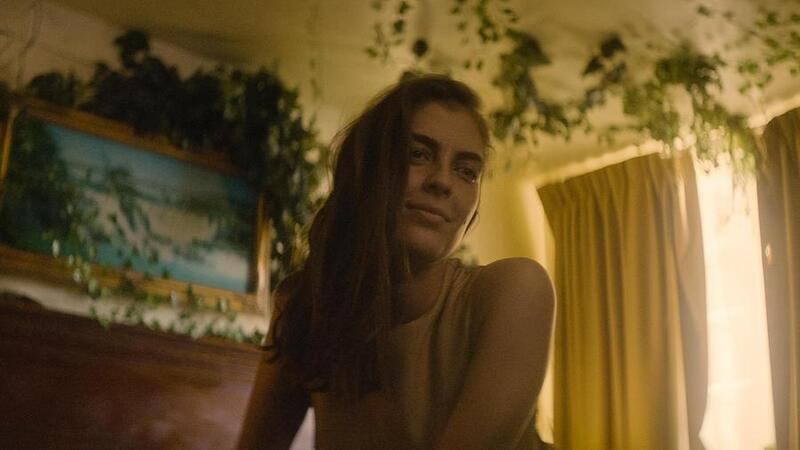
SXSW brought its own wave of films either made during last year’s lockdown, or based on the feeling of it. Many of them have played it more literal, as if trying to be time capsules. But a movie like “Ayar,” directed by Floyd Russ, feels more liberated than many of its like-minded peers. It answers to the creative restrictions of lockdown with exciting artistic abandon, an invigorating approach to see unfold for a movie that then concerns its very creation.
“Ayar” is part COVID horror story, part family drama, part star vehicle, and part behind-the-scenes experience. In one of its layers, it’s about a woman named Ayar (Ariana Ron Pedrique) who yearns to see her five-year-old daughter Jasmine after many months away. But it’s not safe because of COVID, according to her mother Renata (Vilma Vega). Ayar has been also been removed by focusing on a showbiz career in Las Vegas that mostly lead to a bad relationship with a powerful guy, a life choice that has removed Ayar from her family but also echoes that of her mother’s failed dreams. Now Ayar is stuck at a motel where the woman next door violently coughs, and roots starts to take over the walls of Ayar’s room.
In another layer, “Ayar” focuses on the people around its title character, who have their own stories about how they got to where they are now, “now” meaning the making of “Ayar.” The script emphasizes this in different ways—a brief photo slideshow of the actors plays after numerous characters are introduced, a celebration of who they are to match the low-angle camera shots that make them appear grandiose against the aesthetic’s sunny, lens-flare lighting. Later on, “Ayar” then dips into the cast members sharing brief life stories, highlighting the script’s floating ideas about how Ayar and her mother equate their immigrant experiences to performing in a role. One of the many questions the film asks: Why not turn your pandemic project into a tapestry of these different lives and vivid faces?
This is a movie in which the collective mindset is to throw everything together and to see what sticks. By design, not everything works, and there are some elements that are touch-and-go that play out like doors to a different screenplay that are opened but not entered (that’s especially the case with its dream-like COVID stuff). Some aesthetic choices are distractingly cheesy, like any moments it presents a “signal” cutting out, and sometimes the included behind-the-scenes footage feels like it is more adding to the run-time than adding to the story.
But “Ayar” is as experimental and its heart is big—not only does the core of its story about mothers and daughters keep it stable, but its flourishes remain sincere overall. Pedrique and Vega, who co-wrote the script with director Floyd Russ, give rich performances that become fuller as the story swirls and flips; it’s an incredible showcase for both. By the end of the movie, you become entirely aware you are watching the emotional range of Pedrique and Vega on display, and that adds to the overall weight of it; it helps you appreciate all that they’ve brought to this wild story that has personal significance. Perfection is not natural, especially in a pandemic. “Ayar” does not aim for perfection but meaning, and it’s often exhilarating and liberating.
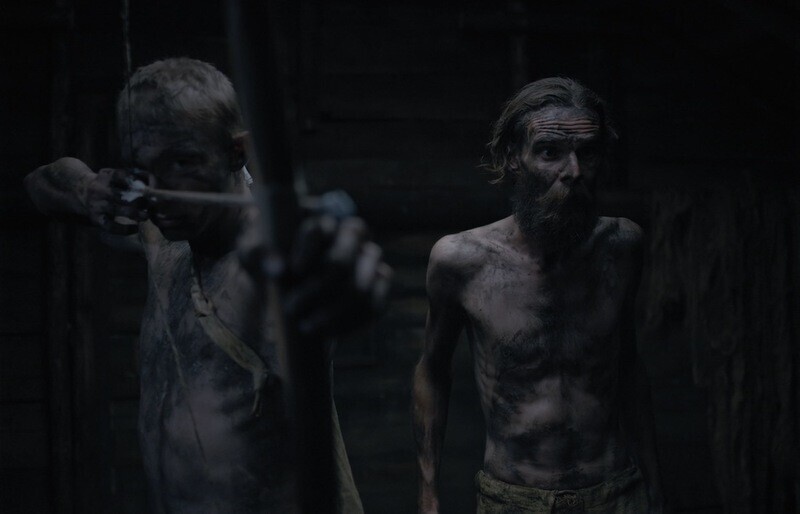
There’s something menacing in the trees—and the dirt, and the mushrooms—in the South African Midnighter “Gaia,” which offers horror fans some unique man vs. nature thrills. It initially starts with the tension between man and technology, as two park rangers are setting up cameras in the woods, and even using a drone. (In one of the film’s more rote horror flourishes, it even begins with an upside down shot, as has been popularized by recent movies released by A24.) The drone is quickly destroyed, by two men covered in dirt and with a knowledge of the woods. One of the rangers, Gabe (Monique Rockman), walks into one of their traps and gets a nasty hole in the foot, something that is bandaged up by the men. They have something else they’re hunting.
It turns out that these are not the film’s main source of fear, but rather it’s the monsters in the night that the two men are keenly aware of. “Gaia” then turns into “man vs. mushroom monster” in a couple of swiftly executed scare scenes where towering fungi terrorize the hut. Key to Bouwer’s direction is that we never get a long enough look at them to be ridiculous or to get comfortable with them, and they become interesting pieces as “Gaia” builds a horror that means more than just things that go fungi in the night.
Now, back to the two men in the forest, a father and son who have been living in their own world. The father (Carell Nel’s Barend) is like a nature zealot, with his own manifesto and towering monologues that spew venom about the modern world and technology. His son Stefan (Alex Van Dyk), takes after his father’s ideologies; their relationship is a Biblical reference in more than one regard to Abraham being willing to sacrifice his son Isaac. But Gabe has the ability to sway him, especially as the two grow closer. It’s when the story settles in—after you get used to monsters in the night, and to the fungi influence—that “Gaia” starts to slack, as if it’s missing some of the story. All of the main three characters are compelling, but their sense of why they do what they do (or why Gabe sticks around) is left a little vague; the script bases a great deal of its energy on the characters’ connections, but they don’t feel entirely formed.
Bouwer tries to spice things up with dream sequences that get trippier and trippier, but they only become more exhausting and repetitive. “Gaia” is instead more significant for its excellent make-up and select special effects, which create creepy body horror using masses of moss and fungi and other organisms in the woods. It applies those feelings effectively to the story’s larger and eerie ominous themes of being trapped, and slowly consumed by a vengeful Mother Nature.

